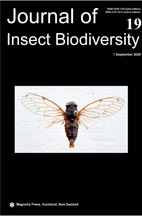Abstract
The genus Olepa is distributed in Palearctic and Oriental regions with more species in India and Sri Lanka. In the recent studies, morphological variations within the group were well established, with couple of first set of mt COI DNA barcodes for at least three species. In the present account, three new species and a new subspecies are described from the northern Western Ghats region of Maharashtra based on mt COI DNA barcode studies. Due to high morphological divergence and complete genetic homogeneity on the mt COI DNA, four morphotypes under two species are reported. Morphological and genital characters of male and female are provided along with their respective species morphotypes for the first time under this genus from India. The genitalia and the habitus of male and female are illustrated. Preliminary phylogenetic tree based on the mt COI DNA sequences available in the GenBank for the genus with the sequences for the new species also provided and discussed.
Key words: new taxa, morphotype, Maharashtra, DNA barcoding, mt COI gene
References
Allison J. D., & Cardé R. T. 2006. Heritable variation in the sex pheromone of the almond moth, Cadra cautella. Journal of chemical ecology 32 (3): 621–641.
https://doi.org/10.1007/s10886-005-9019-2
Ballard J. W. O. & Whitlock M. C. 2004. The incomplete natural history of mitochondria. Molecular Ecology 13 (4): 729–744.
https://doi.org/10.1046/j.1365-294X.2003.02063.x
Balloux F. 2009. The worm in the fruit of the mitochondrial DNA tree. Heredity 104 (5): 419–420.
https://doi.org/10.1038/hdy.2009.122
Conner W. 2009. Tiger Moths and Woolly Bears: Behavior, Ecology, and Evolution of the Arctiidae. Published by Oxford University Press, Inc., New York.128 pp.
Dubatolov V. V. 2011. A new Olepa Watson, 1980 species from South India (Lepidoptera, Arctiidae). Atalanta 42 (1/2): 136–137.
Dufour L. 1844. Anatomiegénérale des diptères. Annales des Sciences Naturelles 1: 244–264.
Fabricius J. C. 1775. Systema entomologiae, sistens insectorum classes, ordines, genera, species adiectis synonymis, locis, descriptionibus, observationibus. Flensburgi et Lipsiae: Officina Libraria Kortii. xxxii + 832 pp.
https://doi.org/10.5962/bhl.title.36510
Galtier N., Nabholz B., Glémin S. & Hurst G. D. D. 2009. Mitochondrial DNA as a marker of molecular diversity: A reappraisal. Molecular Ecology 18(22): 4541–4550.
https://doi.org/10.1111/j.1365-294X.2009.04380.x
Gaur S. K. & Kumar K. A. 2019. Comparative bioefficacy of seed and root extracts of a medicinal plant, Withania somnifera when administered to prepupae of lepidopteran insects, Spodoptera litura (Lepidoptera: Noctuidae) and Pericallia ricini (Lepidoptera: Arctiidae). Journal of Basic and Applied Zoology 80: 37.
https://doi.org/10.1186/s41936-019-0107-1
Grados J. A. 2019. New species of the genus Watsonidia Toulgoët, 1981 (Lepidoptera, Erebidae, Arctiini): example of polymorphism in the Amazon of Peru. Zootaxa 4691(1): 033–046.
https://doi.org/10.11646/zootaxa.4691.1.2
Hadley A. 2010. Combine ZP software, new version. Available from: http://www.hadleyweb.pwp.blueyonder.co.uk/CZP/News.htm (Accessed 16 August 2018).
Hampson G. F. 1894. The fauna of British India including Ceylon and Burma, Moths - volume 3. Taylor and Francis, London, 546 pp.
Hampson G. F. 1901. Catalogue of the Arctiidae and Agaristidae in the collection of the British Museum, 3. 1–690, Taylor and Francis Ltd, London.
Kalawate A. S., Pawara S., Shabnam A., & Dinesh K. P. 2020. DNA Barcode revealed the occurrence of Paleartic Olepa schleini Witt, Müller, Kravchenko, Miller, Hausmann & Speidel, 2005 (Lepidoptera, Erebidae, Arctiinae) from the peninsular India with the report of morphological variations and a new sub species. Journal of Threatened Taxa 12(9): 16143–16152.
https://doi.org/10.11609/jott.5596.12.9.16143-16152
Hebert P. D., Cywinska A., Ball S. L. & Dewaard J. R. 2003. Biological identifications through DNA barcodes. Proceedings of the Royal Society of London. Series B: Biological Sciences 270 (1512): 313–321.
https://doi.org/10.1098/rspb.2002.2218
Klots A. B. 1970. Lepidoptera, pp. 115–130. In: Tuxen, S. L. (ed.), Taxonomist’s glossary of genitalia in insects. Munksgaard, Copenhagen. 359pp.
Markert J. A., Champlin D. M., Gutjahr-Gobell R., Grear J. S., Kuhn A., McGreevy T. J., Roth A., Bagley M. J. & Nacci D. E. 2010. Population genetic diversity and fitness in multiple environments. BMC Evolutionary Biology 10(1): 205.
https://doi.org/10.1186/1471-2148-10-205
Orhant G. 1986. Deuxième contribution à l’étude des lépidoptèreshétérocères du sud-estAsiatique (1) Le complexed’espèces “ricini Fabricius” (Arctiidae: Arctiinae). Bulletin Society Science National France 50: 9–22.
Orhant G. 2000. Unnouvel Olepa de l’Inde (Lepidoptera, Arctiidae, Arctiinae). Lambillionea 100(2): 269–270.
Orhant G. 2012. Olepa neumuthi new species from Thailand (Lepidoptera: Arctiidae). Bulletin Society Entomology Mulhouse 68(4): 61–64.
Pekarsky O. 2012. Two new species of Pseudohadena Alphéraky, 1889 from Kazakhstan (Lepidoptera, Noctuidae, Xyleninae). ZooKeys 187: 9–34.
https://doi.org/10.3897/zookeys.187.2661
Reed D. H. & Frankham R. 2003. Correlation between Fitness and Genetic Diversity. Conservation Biology 17(1): 230–237.
https://doi.org/10.1046/j.1523-1739.2003.01236.x
Roelofs W. L., Liu W., Hao G., Jiao H., Rooney A. P., & Linn C. E. 2002. Evolution of moth sex pheromones via ancestral genes. Proceedings of the National Academy of Sciences 99(21): 13621–13626.
https://doi.org/10.1073/pnas.152445399
Robinson G. S. 1976. The preparation of slides of Lepidoptera genitalia with special reference to the Microlepidoptera. Entomologist’s Gazette 27: 127–132.
Singh N. & Singh J. 2013. Review of the genus Olepa Watson (Lepidoptera: Erebidae: Arctiinae). Tinea 22(4): 272–277.
Swinhoe C. 1885. Proceedings of the general meetings for scientific business of the Zoological Society of London, Proceedings of Zoological Society of London, 295 pp.
https://doi.org/10.1093/molbev/msr121
Walker F. 1855. List of the specimens of Lepidopterous insects in the collection of the British Museum. London: Printed by order of the Trustees 3: 583−775. https://doi.org/10.5962/bhl.title.58221
Walker K. 2007. Oriental tiger moth (Olepa c.f. ricini) Updated on 9/20/2007 10:58:19 AM Available from http://www.padil.gov.au/pests-and-diseases/pest/main/136351/7683# (Accessed 23 September 2019).
Watson A., Fletcher D. S. & Nye I. W. B. 1980. The Generic Names of Moths of the World. Trustees of the British Museum (Natural history), London 2: 1–228.
https://doi.org/10.5962/bhl.title.119421
Wiens J. J. 1999. Polymorphism in Systematics and Comparative Biology. Annual Review of Ecology and Systematics 30: 327–362.
https://doi.org/10.1146/annurev.ecolsys.30.1.327
Witt T. J., Müller G. C., Kravchenko V. D., Miller M. A., Hausmann A. & Speidel W. 2005. A new Olepa species from Israel (Lepidoptera, Arctiidae). Nachrichtenblatt der Bayerischen. Entomologen 54 (3/4): 101–115.
Yan Q, Liu X. L., Wang Y-L., Tang X-Q, Shen Z-J., Dong S-L. & Deng J-Y. 2019. Two Sympatric Spodoptera Species Could Mutually Recognize Sex Pheromone Components for Behavioral Isolation. Frontiers in Physiology 10: 1256.


